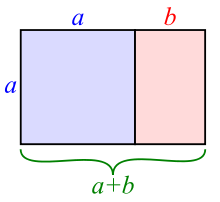黃金比例
| 黃金比 | ||
|---|---|---|
| ||
 黃金比例的線段 | ||
| 命名 | ||
| 名稱 | 黃金比例 黃金分割比 黃金分割率 | |
| 識別 | ||
| 種類 | 無理數 | |
| 符號 | ||
| 位數數列編號 | ||
| 性質 | ||
| 連分數 | ||
| 以此為根的多項式或函數 | ||
| 表示方式 | ||
| 值 | 1.61803... | |
| 代數形式 | ||
| 二進制 | 1.100111100011011101111001… | |
| 十進制 | 1.618033988749894848204586… | |
| 十六進制 | 1.9E3779B97F4A7C15F39CC060… | |
黃金比例(英語:golden ratio),又稱黃金比、黃金分割比[1]、黃金分割率,是數學常數,一般以希臘字母(phi)表示[2][3][4]。可以以下代數式定義:
這也是黃金比一名的由來。
黃金比是無理數,準確值為,約值(小數點後20位,![]() A001622):
A001622):
- =1.61803398874989484820…
應用時一般取1.618,就像圓周率在應用時取3.14159一樣。
黃金比有嚴格的藝術感、和諧感,蘊藏豐富的美學價值,而且呈現於不少動物和植物的外觀。現今普遍很多工業產品、電子產品、建築物或藝術品均應用了黃金比,使其更美觀。
歷史
[編輯]黃金比例是屬於數學領域的專有名詞,但最後涵蓋的內容不只是有關數學領域的研究,根據目前的文獻探討,我們可以說,黃金比的發現和如何演進至今仍是個謎。但有研究指出公元前六世紀古希臘的畢達哥拉斯學派研究過正五邊形和正十邊形的作圖,因此現代數學家推斷當時畢達哥拉斯學派已經觸及甚至掌握了黃金比的一些規則,也發現無理數,但由於其數字崇拜的宗教信仰拒絶承認其存在。它側重於從數學關係去探討美的規律,並認為美就是和諧與比例,按照這種比例關係就可以組成美的圖案,這其實是一個數字的比例關係,即將一條線分成兩部份,長段與短段之比等於全長與長段之比,它們的比例大約是1.618比1,知名的費氏數列也體現了這數學原則,按此種比例關係組成的任何事物都表現出其內部關係的和諧與均衡。
公元前四世紀,古希臘數學家歐多克索斯第一個系統研究了這一問題,並建立起比例理論。公元前300年前後歐幾里得撰寫《幾何原本》時吸收了歐多克索斯的研究成果,進一步系統論述了黃金比,成為最早的有關黃金比的論著(即中末比)[5]。
中世紀後,黃金比被披上神秘的外衣,義大利數學家盧卡·帕喬利稱中末比為神聖比例,並專門為此著書立說。德國天文學家約翰內斯·開普勒稱神聖比例為黃金比。到19世紀黃金比一名才逐漸通行,而證據在於德國數學家馬丁·歐姆所寫的《基本純數學》第2版注釋中有關黃金比的解釋:「人們習慣把按此方式將任一直線分割成兩部份的方法,稱為黃金比」。而在1875年出版的《大英百科全書》第9版中,蘇利有提到:「由費區那……提出的有趣、實驗性濃厚的想法宣稱,『黃金比』在視覺比例上有所謂的優越性。」可見黃金比在當時已甚為流行。20世紀時美國數學家馬克·巴爾給它個名叫phi。黃金比有許多有趣的性質,人類對它的實際應用也很廣泛,造就了它今天的名氣。最著名的例子是優選學的黃金比法或0.618法,是由美國數學家傑克·基弗於1953年首先提出,70年代在中國推廣。
基本計算
[編輯]
兩個數值和構成黃金比例,如果:
一個得出數值的方法是從左邊的分數式入手。經過簡化和代入,
於是:
兩邊乘以就得到:
即是
黃金比奇妙之處在於其倒數為自身減1,即0.618…=1.618…-1,並時常稱為「黃金比例共軛」[6]。
從上面的得到:
0.618…的數值常用希臘字母表示,即:
- =0.6180339887…,亦可表達為:
- =-1=1.6180339887…-1=0.6180339887…
替代或其他形式
[編輯]
而它的倒數是:
平方根表示:
即是:
與其他數學事項的關係
[編輯]黃金比數高精度計算程式碼
[編輯]C++
[編輯]#include <iostream>
#include <stdio.h>
using namespace std;
int main() {
long b, c, d = 0, e = 0, f = 100, i = 0, j, N;
cout << "請輸入黃金分割數位數\n";
cin >> N;
N = N * 3 / 2 + 6;
long* a = new long[N + 1];
while (i <= N) a[i++] = 1;
for (; --i > 0;
i == N - 6 ? printf("\r0.61") : printf("%02ld", e += (d += b / f) / f),
e = d % f, d = b % f, i -= 2)
for (j = i, b = 0; j; b = b / c * (j-- * 2 - 1))
a[j] = (b += a[j] * f) % (c = j * 10);
delete[] a;
cin.ignore();
cin.ignore();
return 0;
}
例子
[編輯]貴金屬分割
[編輯]貴金屬分割即,其中為正整數。時為黃金比(),時為白銀比(),時為青銅比()。用連分數可表示為
參考文獻
[編輯]引用
[編輯]- ^ Summerson John, Heavenly Mansions: And Other Essays on Architecture (New York: W.W. Norton, 1963) p. 37. "And the same applies in architecture, to the rectangles representing these and other ratios (e.g. the 'golden cut'). The sole value of these ratios is that they are intellectually fruitful and suggest the rhythms of modular design."
- ^ Livio, Mario. The Golden Ratio: The Story of Phi, The World's Most Astonishing Number. New York: Broadway Books. 2002 [2016-07-12]. ISBN 0-7679-0815-5. (原始內容存檔於2016-07-07).
- ^ Piotr Sadowski. The knight on his quest: symbolic patterns of transition in Sir Gawain and the Green Knight. University of Delaware Press. 1996: 124 [2016-07-12]. ISBN 978-0-87413-580-0. (原始內容存檔於2016-07-07).
- ^ Richard A Dunlap, The Golden Ratio and Fibonacci Numbers, World Scientific Publishing, 1997
- ^ Strogatz, Steven. Me, Myself, and Math: Proportion Control. New York Times. 2012-09-24 [2016-07-12]. (原始內容存檔於2016-02-12).
- ^ Weisstein, Eric W. (編). Golden Ratio Conjugate. at MathWorld--A Wolfram Web Resource. Wolfram Research, Inc. (英語).
- ^ Max. Hailperin; Barbara K. Kaiser; Karl W. Knight. Concrete Abstractions: An Introduction to Computer Science Using Scheme. Brooks/Cole Pub. Co. 1998. ISBN 0-534-95211-9.
- ^ Brian Roselle, "Golden Mean Series" (頁面存檔備份,存於網際網路檔案館)
- ^ "黃金分割數高精度計算.pdf"[永久失效連結]
來源
[編輯]- 《黃金比例》;遠流出版公司;2004年;ISBN 957-32-5270-8.
註釋
[編輯]延伸讀物
[編輯]- Doczi, György. The Power of Limits: Proportional Harmonies in Nature, Art, and Architecture. Boston: Shambhala Publications. 2005 [1981]. ISBN 1-59030-259-1.
- Huntley, H. E. The Divine Proportion: A Study in Mathematical Beauty. New York: Dover Publications. 1970. ISBN 0-486-22254-3.
- Joseph, George G. The Crest of the Peacock: The Non-European Roots of Mathematics New. Princeton, NJ: Princeton University Press. 2000 [1991]. ISBN 0-691-00659-8.
- Livio, Mario. The Golden Ratio: The Story of PHI, the World's Most Astonishing Number Hardback. NYC: Broadway (Random House). 2002 [2002]. ISBN 0-7679-0815-5.
- Sahlqvist, Leif. Cardinal Alignments and the Golden Section: Principles of Ancient Cosmography and Design 3rd Rev. Charleston, SC: BookSurge. 2008. ISBN 1-4196-2157-2.
- Schneider, Michael S. A Beginner's Guide to Constructing the Universe: The Mathematical Archetypes of Nature, Art, and Science. New York: HarperCollins. 1994. ISBN 0-06-016939-7.
- Scimone, Aldo. La Sezione Aurea. Storia culturale di un leitmotiv della Matematica. Palermo: Sigma Edizioni. 1997. ISBN 978-88-7231-025-0.
- Stakhov, A. P. The Mathematics of Harmony: From Euclid to Contemporary Mathematics and Computer Science. Singapore: World Scientific Publishing. 2009. ISBN 978-981-277-582-5.
- Walser, Hans. The Golden Section. Peter Hilton trans. Washington, DC: The Mathematical Association of America. 2001 [Der Goldene Schnitt 1993]. ISBN 0-88385-534-8.


























![{\displaystyle \varphi =[1;1,1,1,\dots ]=1+{\cfrac {1}{1+{\cfrac {1}{1+{\cfrac {1}{1+\ddots }}}}}}}](https://wikimedia.org/api/rest_v1/media/math/render/svg/95682588ffee3530627c3a7b00ff08bbba6e97d4)
![{\displaystyle \varphi ^{-1}=[0;1,1,1,\dots ]=0+{\cfrac {1}{1+{\cfrac {1}{1+{\cfrac {1}{1+\ddots }}}}}}}](https://wikimedia.org/api/rest_v1/media/math/render/svg/165d255e32f4b9af1f9144f15302b147fc3fead2)


























![{\displaystyle n+{\cfrac {1}{n+{\cfrac {1}{n+{\cfrac {1}{n+{\cfrac {1}{\ddots }}}}}}}}=[n;n,n,n,n,\dots ]}](https://wikimedia.org/api/rest_v1/media/math/render/svg/e95c55de273af96c5fcd4a6cc7fc45fc1022d0f1)





